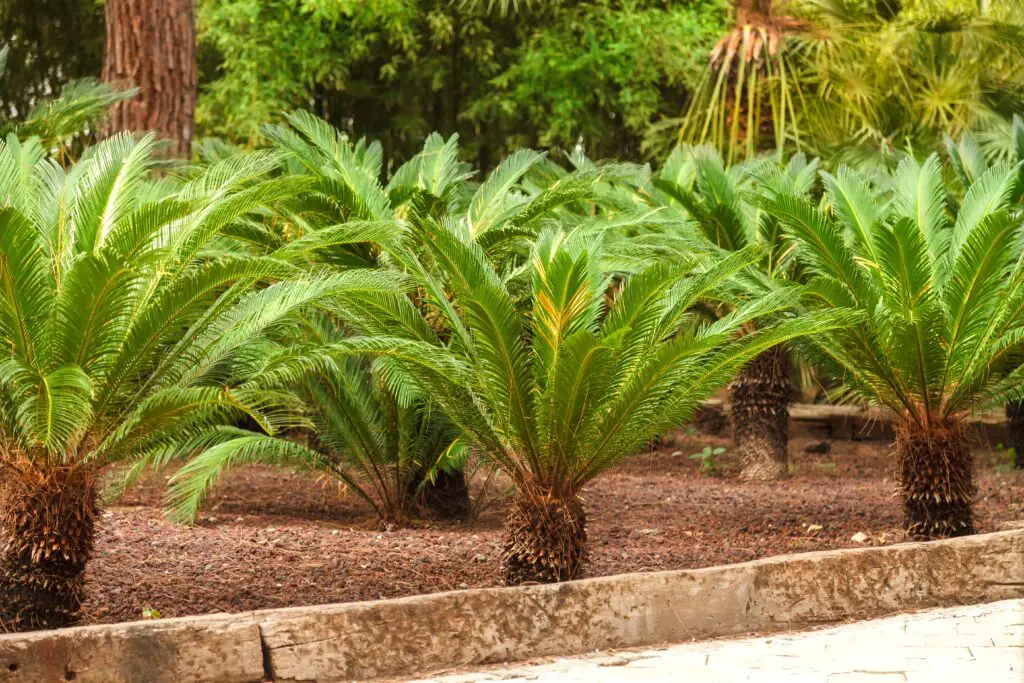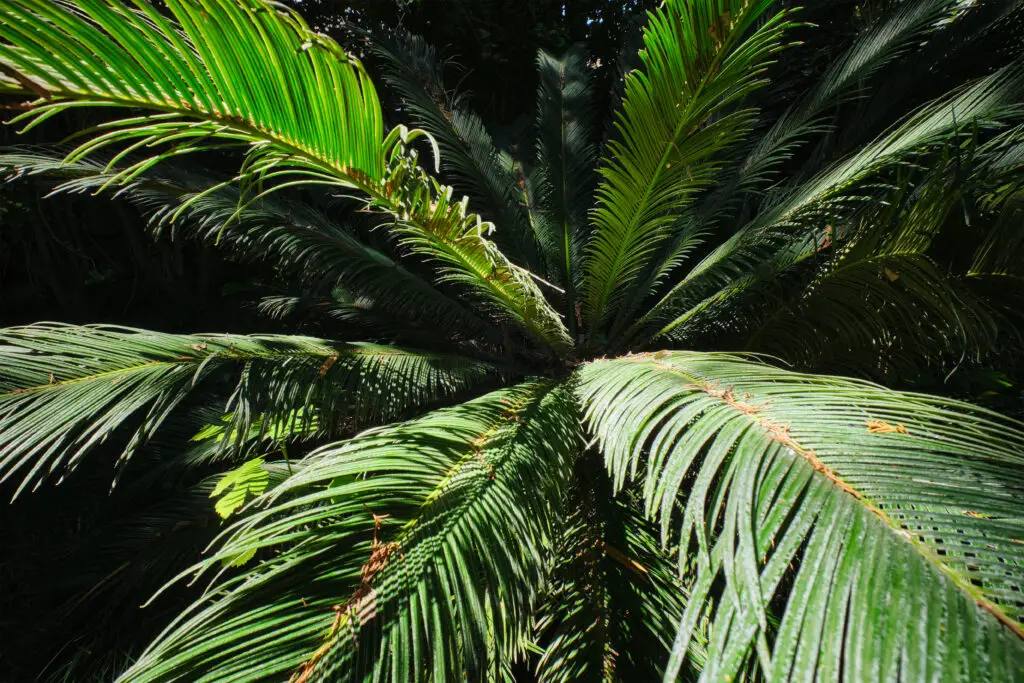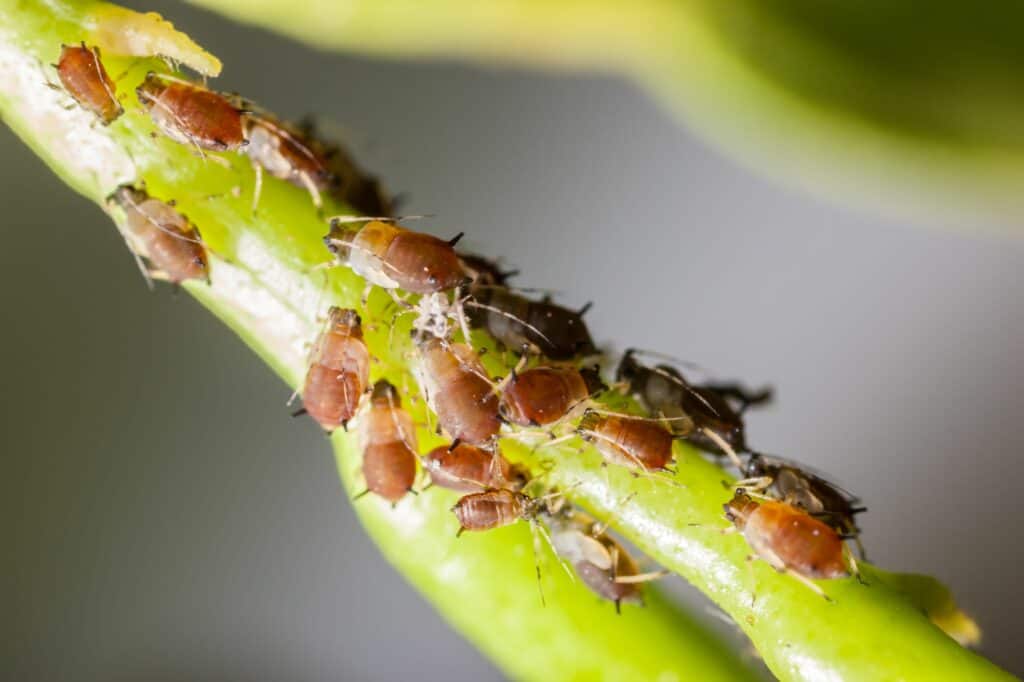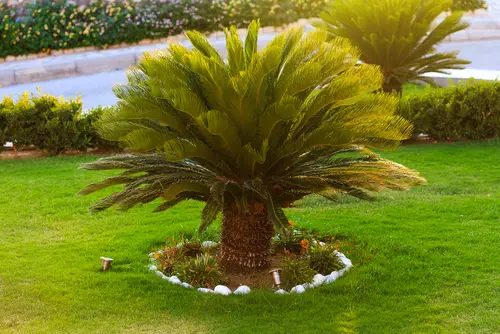Sago palms are a popular ornamental plant that can add a tropical feel to any garden or landscape. However, if you notice your sago palms turning brown, it could be a sign of a problem. Brown leaves on sago palms can be caused by a variety of factors, including nutrient deficiencies, pests, diseases, and poor growing conditions.
Understanding sago palms is important to identify the reasons why they are turning brown. Sago palms are not true palms, but rather cycads that have been around since prehistoric times.
They are slow-growing, with a lifespan of up to 100 years, and can grow up to 10 feet tall. They are also hardy and can tolerate a range of growing conditions, including drought, poor soil, and extreme temperatures.
Despite their hardiness, sago palms are susceptible to a variety of problems that can cause them to turn brown. Common reasons for sago palms turning brown include pests like scale insects and mealybugs, diseases like root rot and manganese deficiency, and poor growing conditions like overwatering or lack of sunlight.
It is important to identify the underlying cause of the problem in order to treat it effectively and prevent further damage to the plant.
Key Takeaways
- Sago palms are cycads that have been around since prehistoric times and are hardy and slow-growing.
- Brown leaves on sago palms can be caused by a variety of factors, including nutrient deficiencies, pests, diseases, and poor growing conditions.
- Identifying the underlying cause of the problem is important to treat it effectively and prevent further damage to the plant.
Also see:
Understanding Sago Palms

Sago palms, also known as cycas revoluta, are a popular landscape plant that can add a touch of posh to any garden. These cycads are native to southern Japan but are now widely cultivated in many parts of the world.
Sago palms are slow-growing and can live for several decades. These plants can grow up to 10 feet tall and have a crown of leaves that can reach up to 6 feet in diameter. The leaves of the sago palm are stiff and pinnate, with a glossy dark green color.
While sago palms are generally easy to care for, they can turn brown for a variety of reasons. Some of the most common reasons for sago palms turning brown include overwatering, underwatering, nutrient deficiencies, and pest infestations.
It is important to note that sago palms are toxic to pets and humans if ingested. All parts of the plant, including the seeds, contain cycasin, a toxic compound that can cause severe gastrointestinal symptoms and liver damage. Therefore, it is essential to keep sago palms out of reach of children and pets.
Sago Palms Turning Brown – 9 Common Problems
Sago palms are popular ornamental plants that can add a tropical touch to any garden or indoor space. However, if you notice that your sago palm is turning brown, it could be a sign of an underlying issue. Here are some common reasons why sago palms turn brown:
1. Inadequate Moisture
Sago palms require a consistent level of moisture to thrive. If the soil is too dry, the leaves may turn brown and wilt. On the other hand, overwatering can lead to root rot, which can also cause the leaves to turn brown. Make sure to water your sago palm regularly, but be careful not to overdo it.
2. Incorrect Watering
In addition to inadequate moisture, incorrect watering can also cause sago palms to turn brown. If you are watering your sago palm too much or too little, it can stress the plant and cause the leaves to brown. Make sure to water your sago palm according to its specific needs.
3. Too Much Sun
Sago palms prefer bright, indirect light, but too much direct sunlight can cause the leaves to turn brown. If your sago palm is located in an area with too much sun exposure, consider moving it to a shadier spot.
4. Sun Scorch

Sun scorch is a common issue that affects many types of plants, including sago palms. It occurs when the leaves are exposed to too much direct sunlight, which can cause them to dry out and turn brown. To prevent sun scorch, make sure to provide your sago palm with adequate shade.
5. Cold Temperature
Sago palms are native to warm, tropical regions, so they are sensitive to cold temperatures. Exposure to cold air or frost can cause the leaves to turn brown and die. If you live in a colder climate, make sure to protect your sago palm from the cold.
6. Low Light Conditions
While sago palms prefer bright, indirect light, they can also tolerate low light conditions. However, if the plant is not getting enough light, the leaves may turn brown. Consider moving your sago palm to a brighter location if you notice this issue.
7. Improper Light
In addition to low light conditions, improper light can also cause sago palms to turn brown. If the plant is getting too much or too little light, it can stress the plant and cause the leaves to brown. Make sure to provide your sago palm with the appropriate amount of light.
8. Transport Shock
Transport shock is a common issue that affects many plants, including sago palms. It occurs when the plant is moved from one location to another, which can stress the plant and cause the leaves to turn brown. If you recently transported your sago palm, give it some time to adjust to its new environment.
9. Relocation
Lastly, if you recently relocated your sago palm to a new spot, it may be experiencing transplant shock. This can cause the leaves to turn brown and wilt. Give your sago palm some time to adjust to its new location, and make sure to provide it with the appropriate amount of water and light.
Pests and Diseases Affecting Sago Palms

Sago palms are generally hardy plants, but they are not immune to pests and diseases. Here are some of the most common problems that can affect sago palms.
Scale
Scale insects are a common problem for sago palms. The most common type of scale found on sago palms is the Aulacaspis scale. These tiny insects attach themselves to the fronds of the plant and suck out the sap, causing the fronds to turn yellow and eventually die. Heavy infestations can lead to the death of the entire plant.
To control scale, it is important to catch the infestation early. You can use insecticidal soap or horticultural oil to kill the insects. Be sure to thoroughly coat the fronds and stems of the plant with the spray. Repeat the treatment every two weeks until the infestation is under control.
Spider Mites
Spider mites are another common pest that can affect sago palms. These tiny insects feed on the sap of the plant, causing the fronds to turn yellow and eventually die. They also produce webs that can cover the plant and make it look unsightly.
To control spider mites, you can use insecticidal soap or horticultural oil. Be sure to thoroughly coat the fronds and stems of the plant with the spray. Repeat the treatment every two weeks until the infestation is under control.
Mealybugs
Mealybugs are another common pest that can affect sago palms. These insects feed on the sap of the plant and produce a white, powdery substance that can cover the fronds and stems of the plant. Heavy infestations can lead to the death of the entire plant.
To control mealybugs, you can use insecticidal soap or horticultural oil. Be sure to thoroughly coat the fronds and stems of the plant with the spray. Repeat the treatment every two weeks until the infestation is under control.
Sooty Mold
Sooty mold is a fungal disease that can affect sago palms. It is caused by the excrement of insects such as scale, mealybugs, and aphids. The excrement provides a food source for the fungus, which grows on the fronds and stems of the plant. Sooty mold can make the plant look unsightly, but it does not usually cause serious damage.
To control sooty mold, you need to control the insects that are producing the excrement. Use insecticidal soap or horticultural oil to kill the insects. Be sure to thoroughly coat the fronds and stems of the plant with the spray. Repeat the treatment every two weeks until the infestation is under control.
Fungal Diseases

Sago palms can also be affected by fungal diseases such as anthracnose and leaf spot. These diseases can cause brown lesions on the fronds and stems of the plant, and can eventually lead to the death of the entire plant.
To control fungal diseases, it is important to keep the plant healthy and well-watered. Avoid over-watering, as this can lead to fungal growth. If you notice any signs of fungal disease, remove the affected fronds and stems and dispose of them properly. Use a fungicide to treat the remaining plant, following the instructions on the label.
Nutrient Deficiencies and Fertilization
Sago palms turning brown is often a sign of nutrient deficiencies or fertilization issues. Proper fertilization is essential for the health and growth of sago palms. This section will discuss the various nutrient deficiencies and fertilization issues that can cause sago palms to turn brown.
1. Manganese Deficiency
Manganese deficiency is a common cause of sago palms turning brown. Manganese is an essential micronutrient that sago palms need to grow and thrive. When the soil lacks manganese, sago palm leaves can turn yellow and brown. Manganese sulfate is an effective treatment for manganese deficiency.
2. Micronutrient Deficiency
Sago palms require a balanced combination of micronutrients to grow healthy and strong. A micronutrient deficiency can cause yellowing and stunt new growth. Magnesium sulfate and balanced plant food are effective treatments for micronutrient deficiencies.
3. Over Fertilizing
Over fertilizing can cause excess salts in the soil, which can lead to brown tips on sago palms. Occasional fertilizing is recommended to avoid over fertilizing.
4. Proper Fertilization

Proper fertilization is essential for the health and growth of sago palms. A balanced fertilizer with a ratio of 8-8-8 is recommended. It is also important to test the nutrient levels in the soil periodically to ensure that the sago palm is receiving the necessary nutrients.
5. Occasional Fertilizing
Occasional fertilizing is recommended to avoid nutrient deficiencies and supplement inadequacy. A balanced plant food with micronutrients should be used for occasional fertilizing. It is important to avoid over fertilizing, as it can cause excess salts in the soil.
Sago Palm Care
Sago palms are popular ornamental plants that can add a tropical touch to any garden or indoor space. However, they can turn brown due to various reasons, including improper care. To prevent this, it’s important to provide the right conditions for your sago palm to thrive.
1. Soil and Watering
Sago palms prefer well-draining soil that is moist but not waterlogged. Overwatering can lead to root rot, while underwatering can cause the leaves to turn brown and dry out. To prevent this, it’s important to water your sago palm thoroughly but infrequently. Allow the soil to dry out slightly between waterings, and avoid getting water on the leaves.
When planting a sago palm, use a well-draining potting mix and ensure that the root zone is not too deep. If the soil is sandy or acidic, amend it with lime or dolomite to raise the pH level.
2. Light and Temperature

Sago palms prefer bright, indirect light. Direct sunlight can scorch the leaves, while improper light can cause the leaves to turn brown and fall off. If your sago palm is not getting enough light, consider moving it to a brighter location or supplementing with artificial light.
Sago palms can tolerate a range of temperatures, but they prefer warm, humid conditions. Cold temperatures can damage the leaves and cause them to turn brown. If you live in an area with cold winters, consider bringing your sago palm indoors or protecting it with a frost cloth.
3. Pruning and Fertilizing
Sago palms do not require much pruning, but it’s important to remove any dead or damaged leaves to prevent the spread of disease. Use clean, sharp pruning shears to make a clean cut.
Sago palms require occasional fertilizing with a slow-release, balanced plant food. Overfertilizing can cause the leaves to turn brown and damage the roots. Follow the instructions on the fertilizer package and avoid applying too much fertilizer.
4. Preventing Pests and Diseases
Sago palms are generally low maintenance, but they can be susceptible to pests and diseases. To prevent this, ensure that your sago palm is planted in well-draining soil and avoid overwatering. Monitor your plant regularly for signs of pests or diseases, such as yellowing leaves or brown spots.
If you notice any issues, treat them promptly with an appropriate pesticide or fungicide. It’s also a good idea to keep your sago palm’s environment clean and free of debris, which can harbor pests and diseases.
Frequently Asked Questions
Why are the leaves on my sago palm turning yellow?
Yellowing leaves on sago palms can be caused by several factors, including nutrient deficiencies, over or under watering, and too much or too little sunlight.
One common cause of yellowing leaves is a manganese deficiency in the soil. This can be corrected by adding manganese supplements to the soil or using a fertilizer that contains manganese.
Why are my cycad leaves turning brown?
Cycads, including sago palms, can develop brown leaves for a variety of reasons. Brown leaves can be a sign of nutrient deficiencies, insect damage, or over or under watering.
In some cases, brown leaves can be caused by exposure to extreme temperatures or too much direct sunlight. It is important to identify the underlying cause of brown leaves in order to treat the problem effectively.
What is the best fertilizer for sago palms?
Sago palms benefit from fertilizers that are high in nitrogen, potassium, and manganese. A slow-release fertilizer is recommended, as it will provide nutrients to the plant over a longer period of time. It is important to avoid over-fertilizing, as this can cause salt buildup in the soil and damage the plant.
How do you treat freeze damage on sago palms?
Sago palms can be damaged by freezing temperatures, which can cause brown leaves and damage to the trunk. In mild cases, the plant may recover on its own.
In more severe cases, damaged leaves and branches should be removed and the plant should be covered to protect it from further damage. It is important to avoid pruning the trunk, as this can cause further damage to the plant.
What is the recommended treatment for sago palm disease?
Sago palms can be affected by a number of diseases, including fungal infections and scale infestations. It is important to identify the specific disease affecting the plant in order to treat it effectively.
In some cases, fungicides or insecticides may be necessary to treat the problem. It is also important to maintain good plant hygiene and avoid over-watering, as this can promote the growth of fungal infections.
Is it necessary to cut brown leaves off sago palms?
Brown leaves on sago palms can be unsightly, but they may not necessarily need to be removed. In some cases, brown leaves may still be providing nutrients to the plant and should be left in place.
However, if the brown leaves are affecting the overall appearance of the plant, they can be removed using sharp, clean pruning shears. It is important to avoid removing too many leaves at once, as this can stress the plant.

Hey, I’m Lisa and I’ve been an avid gardener for over 30 years. I love writing, talking and living in the garden! Feel free to connect with me on my socials below


